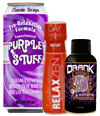
Debate about the use of melatonin in relaxation drinks and shots has thrust the emerging category into the national spotlight as beverage manufacturers, consumers and federal regulators disagree over its use in drinks.
Melatonin, which has been used to treat insomnia and jet lag, has yet to receive the U.S. Food and Drug Administration’s generally regarded as safe status for food and beverages. The FDA sent a letter earlier this year to Houston-based Innovative Beverage Group Inc. explaining that melatonin could not be used as a food additive. However, the ingredient can be used in dietary supplements.
A former professional musician, Innovative Beverage Group’s Chief Executive Officer Peter Bianchi says that he has been on a regimen of melatonin and valerian root, another ingredient used for relaxation, for years to calm his nerves before performing on stage. Innovative Beverages Group worked for nearly three years to develop an efficacious product, he says.
This spring, Innovative Beverage Group changed its labels to reflect that its relaxation beverage, Drank, is a dietary supplement, allowing it to continue using melatonin, Bianchi says.
Bianchi, like other relaxation beverage manufacturers, compares the arc of success for relaxation beverages to that of energy drinks. “There are countries that banned the products, cities that wouldn’t carry the product, all because of ingredients,” he says.
Although melatonin has garnered the most attention, many beverage companies are using other ingredients to give their drinks relaxation properties. L-theanine, a natural amino acid, frequently is incorporated to aid mental focus. Valerian root, another common ingredient in relaxation beverages, is an herb that has shown to help relieve stress, relaxation beverage companies say. Many relaxation beverages also include rose hips because it has been said to help relieve stress.
But melatonin’s use in some relaxation drinks has caused consumers to believe that all relaxation drinks include the ingredient, says Darrell Duchesneau, chief executive officer of Funktional Beverages Inc., Spring, Texas. Funktional Beverages Inc. makes Purple Stuff, a soda that contains valerian root extract, rose hips and L-theanine, to promote relaxation but does not use melatonin.
Roots of relaxation
Relaxation beverage companies might not agree on using melatonin in their drinks, but a consensus exists among executives and industry analysts that the category was born from and is following a similar path to energy drinks.
“In the past, drinks that had a relaxation claim or a relaxation image were pretty much limited to the tea category and maybe some herbal beverages,” says Sarah Theodore, an analyst with Mintel International, Chicago. “Today’s relaxation drinks are much more closely related to energy drinks.”
Although relaxation ingredients – such as valerian root, rose hips, L-theanine and melatonin – are intended to relax the body, relaxation beverages are branded as energetic and edgy, Theodore says. Like the early stages of energy drink development, the relaxation beverage category is full of smaller, emerging companies, and a single dominant company has yet to establish itself, she says.
Energy drinks have helped change the consumer mindset to expect beverages will deliver a benefit in addition to thirst quenching, Theodore says.
“The acceptance of functional beverages has been proven by Gatorade, Red Bull, 5-Hour and Vitaminwater,” says Brent Sonnek-Schmelz, chief zen officer of RelaxZen Inc., Schrewsbury, N.J. “The question is whether they will accept relaxation as a function. My feeling is they will.”
In addition to other relaxation ingredients, Sonnek-Schmelz credits energy drinks with helping convince consumers to buy functional shots. “That is incredible. Without energy, we wouldn’t exist,” he says.
Sonnek-Schmelz says that the on-the-go lifestyle of today’s consumers coupled with stress from work, the economy and politics have combined to create the need to relax.
RelaxZen developed a line of 2.5-ounce relaxation shots formulated with GABA, L-theanine, L-threonine and passion flower. GABA is an amino acid that has been shown in research to reduce beta brain waves and relax the brain. L –threonine is an amino acid that is said to aid in a healthy nervous system. The passion flower herb, which is also used as an herbal supplement, has sedative qualities, companies say.
RelaxZen is available in Day, Night, Sport, Day Flight and Night Flight varieties. The company’s Night shot also contains melatonin.
Consumer expectations about functionality in their beverages stems from an overall cultural shift toward wanting individual products to address multiple needs, Funktional Beverage’s Duchesneau says. Duchesneau’s company does not classify its beverage Purple Stuff exclusively as a relaxation beverage, but as a healthy soda with relaxation properties. Purple Stuff uses valerian root and L-theanine to give the beverage its relaxation properties. It does not use caffeine and contains about 50 calories, Duchesneau says.
New products
As buzz around relaxation beverages continues, the category is growing with new beverages that make a relaxation claim.
Memphis-based Frontier Beverage Co. introduced Unwind, a low-calorie relaxation aide, in Citrus Orange, Grape and Pom Berry flavors. The company originally released Citrus Orange in a limited run of 16-ounce cans. Now, Citrus Orange, Grape and Pom Berry varieties all are available in 12-ounce cans.
VIB Holdings LLC, Dallas, offers Pomegranate Berry and Mango Lime varieties of its Vacation in a Bottle relaxation beverage. The products are formulated with L-theanine and L-threonine to give it relaxation properties. The drink contains 40 calories per 8-ounce serving, and it is packaged in a 12-ounce bottle.
Neurobrands LLC, Santa Monica, Calif., released its 14.5-ounce NeuroSleep relaxation beverage, which includes melatonin, L-theanine and magnesium, an electrolyte that the company says helps promote relaxation.
Relaxation shots also have become more popular, similar to the trend energy drinks followed, Mintel’s Theodore says.
“All of the major energy drink brands have introduced a shot format, so it’s sort of the next logical progression of this category as well,” she says.
Stacker 2 released a Rest & Relaxation shot formulated with valerian root, passion flower and chamomile. Earlier this year, Arizona Beverage Co., Lake Success, N.Y., launched Fast Shots in three varieties, including a P.M. Relax Fast Shot that includes chamomile and GABA.
Irving, Texas-based iChill Beverages LLC developed a relaxation shot that includes a blend of melatonin, valerian root, rose hips and B vitamins in a Blissful Berry flavor. The shot is sweetened with stevia, a zero-calorie, natural sweetener.
In November 2009, Innovative Beverage Group released a relaxation shot, Drank Deuce, to complement the Drank line of relaxation beverages. The 2-ounce shot includes B vitamins, valerian root, rose hips and melatonin. BI

